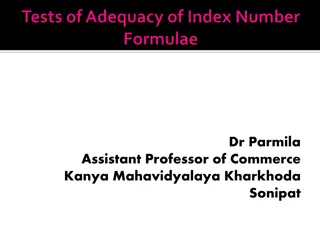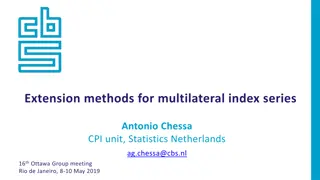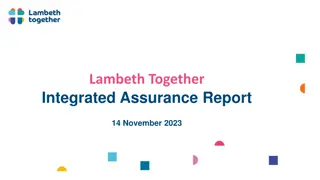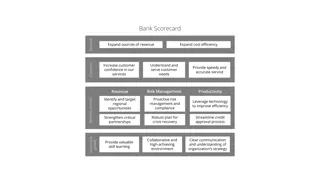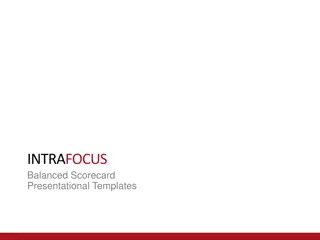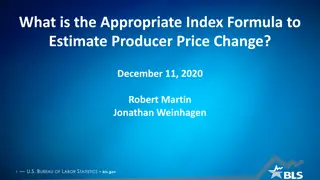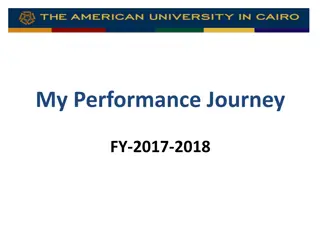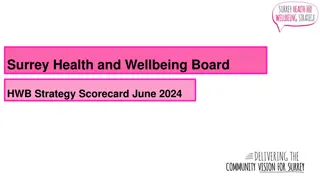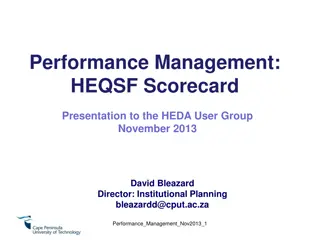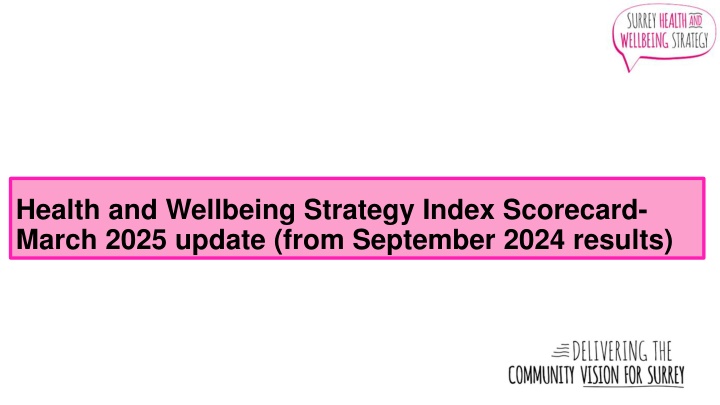
Surrey's Health and Wellbeing Strategy Progress
Explore the latest update on Surrey's Health and Wellbeing Strategy, focusing on reducing health inequalities and community-led approaches, with a detailed scorecard and indicators for tracking progress at different levels.
Download Presentation

Please find below an Image/Link to download the presentation.
The content on the website is provided AS IS for your information and personal use only. It may not be sold, licensed, or shared on other websites without obtaining consent from the author. If you encounter any issues during the download, it is possible that the publisher has removed the file from their server.
You are allowed to download the files provided on this website for personal or commercial use, subject to the condition that they are used lawfully. All files are the property of their respective owners.
The content on the website is provided AS IS for your information and personal use only. It may not be sold, licensed, or shared on other websites without obtaining consent from the author.
E N D
Presentation Transcript
Health and Wellbeing Strategy Index Scorecard- March 2025 update (from September 2024 results)
The Health and Wellbeing Strategy The Surrey Health and Wellbeing Strategy was refreshed in early 2022 in response to COVID-19, to ensure it had a greater focus on reducing health inequalities, so no-one is left behind. In the refreshed Strategy there was also a commitment to community capacity building, co-designing and co- producing responses to problems, and community led action; these principles for working with communities are crucial to our success. Delivering the Strategy continues to play a crucial role in achieving the 'Community Vision for Surrey in 2030 .The strategy is published on the Healthy Surrey website. Partners in Surrey are measuring the long-term impact of the Health and Wellbeing Strategy on reducing health inequalities in Surrey using the Health and Wellbeing Strategy Index. The purpose of the Index is to measure progress against the Health and Wellbeing Strategy s Priorities, Outcomes, and meeting the needs of our Priority Populations (including the Key Neighbourhoods), where the data is available. The Index combines appropriate physical, mental and wider determinants of health indicators into baskets at different geographic levels. These allow us to see improvements that come from working together in partnership. The Index is calculated on an annual basis but not all data is from the same year; the most recent data available is used for each indicator. Alongside the Index are overarching indicators around life expectancy, healthy life expectancy and inequality in life expectancy, and indicators currently available for some of the Priority Populations at a Surrey-wide level. These indicators and the Index are presented in an interactive dashboard available on the surrey-i website.
The Health and Wellbeing Strategy Scorecard This Scorecard presents a simple to read summary of the findings in the HWB Strategy Index, outlining overall progress against the HWB Strategy to help gauge system-wide success (or otherwise) and support the direction of appropriate interventions related to the Priority Populations and Outcomes in the HWB Strategy where improvement is required. The Index section helps us understand needs at a place level and is currently published at a borough and district, Primary Care Network and ward level geographies, but this Scorecard also includes indicators for the whole county to present a Surrey-wide picture of progress. The first results presented on the Scorecard are the published overarching indicators, which are a measure of the long-term impact of the Strategy. This is followed by results published for indicators for some of our Priority Populations of identity, where data is available. Both these sets of indicators are published at a county level to present a Surrey-wide picture. The results published at a borough and district, Primary Care Network and ward level geographies* then follow and present progress against the HWB Strategy's Outcomes, grouped by the three Priorities. These help us understand progress and compare need at a more local level. Note: Spelthorne is highlighted in brown text as it has poorest results across 18 outcome indicators. SASSE 3 PCN is highlighted in orange text as it has poorest results across 7 outcome indicators. HWB Strategy Key Neighbourhoods are highlighted in pink text. Waiting for trend data highlighted in yellow text
Overarching Indicators: Life Expectancy at Birth Life Expectancy at Birth 86 Life expectancy at birth is a measure of how long a person will live in years. For males and females in Surrey life expectancy is better than the regional average. There has been an increase in life expectancy in Surrey for both females and males (in line with regional and national trends) in 2021-23. This has been the first increase since 2017-2019. 84 82 80 78 76 At ward level there is a 10-year difference for males and 12-year difference for females between the best and worst wards (based on previous ward geographies, where there were a total of 187 wards in Surrey). 74 72 2001 - 03 2002 - 04 2003 - 05 2004 - 06 2005 - 07 2006 - 08 2007 - 09 2008 - 10 2009 - 11 2010 - 12 2011 - 13 2012 - 14 2013 - 15 2014 - 16 2015 - 17 2016 - 18 2017 - 19 2018 - 20 2019 - 21 2020 - 22 2021 - 23 South East (male) Surrey (male) South East (female) Surrey (female) 2014-16 2015-17 2016-18 2017-19 2018-20 2019-21 2020-22 2021-23 South East (female) Surrey (female) South East (male) Surrey (male) Change from previous reporting period 84.1 84 83.98 84.06 84.21 84.07 83.94 83.84 Increase 85.0 84.61 84.75 85.05 85.27 84.97 84.74 84.65 Good to be high Decrease 80.57 80.3 80.54 80.51 80.7 80.48 80.22 80.12 81.5 81.38 81.4 81.63 81.96 81.5 81.28 81.14
Overarching Indicators: Inequality in Life Expectancy at Birth Inequality in life expectancy at birth is a measure of the difference in life expectancy in years between someone living in the most deprived decile in the county and someone living in the least deprived decile. This inequality is lower in Surrey for both males and females compared to the region and has fluctuated up and down by small margins over the past few years. There has been a 1-year increase in inequality since 2014-16 for females and 0.8-year increase for males over the same period. The longer-term trend in Surrey is an increase in inequality for females but no change for males. Change from previous reporting period 2010-12 7.5 6.2 5.3 4.3 2011-13 7.6 6.1 5.4 4.6 2012-14 7.5 6 5.5 4.7 2013-15 7.8 5.9 5.5 4.7 2014-16 7.8 5.6 5.7 4.4 2015-17 8 5.9 5.9 4.6 2016-18 7.9 5.8 6 4.7 2017-19 7.8 6.1 6.1 5.3 2018-20 7.9 6.2 6 5.4 South East (male) Surrey (male) South East (female) Surrey (female) Increase Good to be low Decrease No Change
Overarching Indicators: Healthy Life Expectancy at Birth Healthy life expectancy at birth is a measure of the average number of years a person would expect to live from birth in good health. This is better for males and females in Surrey than the regional average. There has been some notable fluctuations in past years for males and females. Healthy Life Expectancy at Birth 72 70 68 66 64 The most recent trend in the available data is downwards, with a very sharp decrease of 2.1 years of healthy life expectancy for males and 3.2 years for females in Surrey between 2018- 20 and 2021-23, in line with decreases in South East. 62 60 58 2010 - 12 2011 - 13 2012 - 14 2013 - 15 2014 - 16 2015 - 17 2016 - 18 2017 - 19 2018 - 20 2021-23 South East (male) Surrey (male) South East (female) Surrey (female) Change from previous reporting period 2010-12 2011-13 2012-14 2013-15 2014-16 2015-17 2016-18 2017-19 2018-20 2021-23 65.5 65.4 65.9 65.9 66.1 68.1 68 67.4 68.6 68.8 66.1 68.3 65.6 68.6 65.3 67.2 65.5 67.8 63.5 65.7 South East (male) Surrey (male) South East (female) Surrey (female) Increase Good to be high Decrease 67 66.4 66.4 66.7 66.3 66.2 66.9 65.9 65.9 64.4 No Change 68.6 69.5 68.9 68.7 68 68.7 71.2 69.4 69.7 66.5
Priority Populations: Adult Carers with Enough Social Contact This is a measure of the percentage of adult carers (aged 18+) who have as much social contact as they would like. Adult Carers with Enough Social Contact 45 40 Surrey has generally performed below the national and regional average on this survey-based measure. After a slight improvement in 2021-22, there has been a drop of 4.1% in Surrey, in line with the regional but against the national trend. 35 30 25 20 15 10 5 0 2012 - 13 2014 - 15 2016 - 17 2018 - 19 2021 - 22 2023-24 England South East Surrey O Change from previous reporting period 2012-132014-152016-172018-192021-222023-24 41.4 38.5 35.5 37.7 35.5 33.2 35.9 35.8 28 32.5 31.4 22.4 28 27.9 30.9 30.0 25.9 26.8 England South East Surrey Good to be high Increase Decrease
Priority Populations: Adult Social Care Users with Enough Social Contact This is a measure of the percentage of adult social care service users (aged 18+) who have as much social contact as they would like. Surrey has generally performed above the national average on this survey-based measure, although the difference is not statistically significant, and has followed the trend seen regionally and nationally. This has included a gradual increase in the percentage of Adult Social Care users who have as much social contact as they would like since 2010, but is marked by a recent decline, particularly during the Covid-19 pandemic. The performance shows signs of recovery in 2022-23 however. O Change from previous reporting period 2010-11 2011-12 2012-13 2013-14 2014-15 2015-16 2016-17 2017-18 2018-19 2020-21 2021-22 2022-23 41.9 42.3 43.2 44.5 44.8 45.4 41.2 41.4 43.9 45.3 47.1 46.8 42.8 43.5 42.9 49.4 44.1 46.4 Increase England South East Surrey 45.4 46.6 47.0 46.0 47.0 49.2 45.9 47.8 48.9 45.9 45.5 47.3 40.6 40.7 40.8 44.4 45.2 46.2 Good to be high Decrease No change
Priority Populations: Employment Gap for those with a Physical or Mental Long Term Health Condition Employment Gap for Physical or Mental Long Term Health Conditions This is a measure of the percentage gap in the employment rate between those with a physical or mental long-term health condition (aged 16 to 64) and the overall employment rate. For example, if 80% of the wider population is employed compared to 70% of those with a physical or mental long-term health condition, the gap is 10%. 20 18 16 14 12 10 Despite improvements in Surrey since 2021/22, latest result shows an increase in the employment gap of .7%. However, this increase is in line with increases nationally and in the Sout East. 8 6 4 2 0 2013-14 2014-15 2015-16 2016-17 2017-18 2018-19 2019-20 2020-21 2021-22 2022-23 England South East Surrey Change from previous reporting period 2013-14 2014-15 2015-16 2016-17 2017-18 2018-19 2019-20 2020-21 2021-22 2022-23 13.1 12.8 12.9 12.1 11.5 11.5 9.8 11.1 9.6 9.1 10.2 8.0 6.0 6.4 7.7 11.5 9.1 5.2 10.6 8.4 7.4 10.7 8.9 5.9 Increase 9.9 8.1 5.7 10.4 9.4 6.4 England South East Surrey Good to be low Decrease No Change
Priority Populations: Employment Gap for Adults with a Learning Disability This is a measure of the percentage gap in the employment rate between those who are in receipt of long-term support for people with a learning disability (aged 18 to 64) registered with adult social care and the overall employment rate. For example, if 80% of the wider population is employed compared to 10% of adults with a learning disability, the gap is 70%. Employment Gap for Learning Disabilities 75 70 65 The current employment gap of 68.2% in Surrey is significantly wider than the narrowest point seen in the trend (65% in 2012-13) but has narrowed since 2018- 19 (when it was 72.4%). Little progress in the four years 2019 2023 but the gap remains lower than the gap nationally and in the South East. 60 55 50 2012-13 2013-14 2014-15 2015-16 2016-17 2017-18 2018-19 2019-20 2020-21 2021-22 2022-23 England South East Surrey Change from previous reporting period 2012-13 2013-14 2014-15 2015-16 2016-17 2017-18 2018-19 2019-20 2020-21 2021-22 2022-23 64 65 66.9 68.1 68.7 69.2 64.7 67.4 68.7 71 71.6 72 65 66.6 68.7 70 72.3 68.7 Increase 69.7 72 72.4 70.6 72.7 68 70 71.1 67.5 70.6 71.5 67.5 70.9 71.4 68.2 England South East Surrey Good to be low Decrease No Change
Priority Populations: Employment Gap for Adults in Contact with Secondary Mental Health Services This is a measure of the percentage gap in the employment rate between those who are in contact with secondary mental health services (aged 18 to 69) and the overall employment rate (aged 16-64). For example, if 80% of the wider population is employed compared to 10% of adults in contact with secondary mental health services, the gap is 70%. This indicator was previously the employment gap for adults in contact with secondary mental health services and on the Care Programme Approach (CPA) but changed in 2021-22 to be all those contact with secondary mental health services because the CPA was superseded by the Community Mental Health Framework. Since 2018-2019, Surrey's progress has been significantly worse compared to nationally and regionally and is over 8% worse compared to both on the new indicator. Change from previous reporting period 2013-14 64.7 68.9 71 2014-15 66.1 69.5 68.3 2015-16 67.2 70.5 72.3 2016-17 67.4 69.7 68.5 2017-18 68.2 70.5 65.7 2018-19 67.6 69.4 70.7 2019-20 67.2 70.6 71.3 2020-21 66.1 66.7 71.1 2021-22 69.4 70.1 78.2 2011-12 61.3 66.5 69.5 2012-13 62.2 65.4 68.1 Increase England South East Surrey Good to be low Decrease No Change New Definition
Priority Populations: Adults with a Learning Disability Living in Stable and Appropriate Accommodation This is a measure of the percentage of adults (aged 18 to 64) with a learning disability registered with adult social care who are living in stable and appropriate accommodation as a percentage of adults with a learning disability. Adults with a Learning Disability Living in Stable and Appropriate Accommodation 85 80 75 Despite the percentage increase of 18.1% from 2018-19 to 2022-2023, Surrey is now performing 6.4% worse than the national average and 3.5% worse that the regional on this measure, with results having fallen by 2.2%. 70 65 60 55 50 2013-14 2014-15 2015-16 2016-17 2017-18 2018-19 2019-20 2020-21 2021-22 2022-23 2023-24 England South East Surrey O Change from previous reporting period 2013-14 74.9 70.6 67.7 2014-15 74 68.4 64.2 2015-16 75.4 70.2 67.7 2016-17 76.2 71.3 65.9 2017-18 77.2 72.8 66.4 2018-19 77.4 70.7 59.3 2019-20 77.3 71.8 68.1 2020-21 78.3 75.6 73.4 2021-22 78.7 76.2 75.2 2022-23 80.5 78.3 77.4 2023-24 81.6 78.7 75.2 Increase England South East Surrey Good to be high Decrease No Change
Priority Populations: Adults in Contact with Secondary Mental Health Services in Stable and Appropriate Accommodation This is a measure of the percentage of adults who are receiving secondary mental health services on the Care Programme Approach (CPA) recorded as living independently, with or without support, out of all adults who are receiving secondary mental health services and are on the CPA (aged 18 to 69). There has been some notable fluctuation in the past few years, with a 31.4% increase from 2015-16 to 2017-18, followed by a 23.0% reduction to the current reporting period of 2020-21. Surrey s current progress is 13% worse than the regional average and 10% worse than the national average. Change from previous reporting period 2011-12 54.6 42.7 43.5 2012-13 58.5 56.3 44.4 2013-14 60.8 51.5 41.7 2014-15 59.7 51.0 45.3 2015-16 58.6 48.2 39.6 2016-17* 54.0 45.0 64.0 2017-18 57.0 48.0 71.0 2018-19 58.0 56.0 58.0 2019-20 58.0 52.0 55.0 2020-21 58.0 61.0 48.0 Increase England South East Surrey Good to be high Decrease No Change * There is a reported data quality issue with this value
Priority 1: Supporting People to Lead Healthy Lives by Preventing Physical Ill Health and Promoting Physical Wellbeing Outcome 1: People Have a Healthy Weight and are Active Change from previous Surrey result Latest Primary Care Network result Good to be Latest Surrey result Latest Borough and District result Latest Ward result Indicator Best: Bellfields Bellfields and and Slyfield Slyfield (Guildford) 76.97% Worst: Ashford Ashford North and North and Stanwell Stanwell South South (Spelthorne) 58.30% Adults who are physically active (doing at least 150 minutes of moderate intensity activity in the past week) Best: Elmbridge 75.3% Worst: Epsom and Ewell 74.5% Best: Guildford East PCN 73.5% Worst: SASSE 3 SASSE 3 PCN PCN 61.8%* * - -0.7 0.7 69.9% 69.2% High High (Nov 2022-23) (Nov 2021-22) Best: Thames Ditton (Elmbridge) 12.50% Worst: Stanwell Stanwell North North (Spelthorne) 30.72% Adults who are physically inactive (doing less than 30 minutes of moderate intensity activity in the past week) Best: East Elmbridge PCN 15.8% Worst: SASSE 3 SASSE 3 PCN PCN 25.5%* * Best: Tandridge 21.7% Worst: Epsom and Ewell 17.2% + 0.7% + 0.7% 19.5% 20.2% Low Low (Nov 2022-23) (Nov 2021-22) Children who are physically active (doing an average of 60+ minutes of moderate intensity activity per day) - -2.8 2.8 48.9% Best: Mole Valley 55.0% Worst: Surrey Heath 36.0% 46.1% (Academic Year 2022-23) Data not available at this geography Data not available at this geography High High (Academic Year 2021- 22) Change from previous reporting period Proportion of residents who reported eating five or more portions of fruit and/or vegetables yesterday** Best: Elmbridge 37.2% Worst: Reigate and Banstead 24.0% 32.1% (December 2024) -7.4 39.5% Decline Data not available at this geography Data not available at this geography High High (December 2023) Improvement No data trend available *PCN level data is for November 2021-22 **Response to the Joint Neighbourhood Survey
Priority 1: Supporting People to Lead Healthy Lives by Preventing Physical Ill Health and Promoting Physical Wellbeing Outcome 2: Substance Misuse is Low (page 1 of 2) Change from previous Surrey result Latest Primary Care Network result Good to be Latest Surrey result Latest Borough and District result Latest Ward result Indicator Admission episodes for alcohol-related conditions (standardised rate per 100,000) Best: Epsom and Ewell 1,176* Worst: Spelthorne Spelthorne 1,911 +251 1,260 (2020-21) 1,511 (2021-22) Data not available at this geography Data not available at this geography Low Low Best: Elmbridge 2.6** Worst: Woking 3.8 Rate of deaths from drug misuse (standardised rate per 100,000) -0.2 2.5 2.3 Data not available at this geography Data not available at this geography Low Low (2020-22) (2019-20) Change from previous reporting period Decline Improvement * The value cannot be calculated for three boroughs due to Frimley Health Foundation trust submitting no HSE data between June 2022 and March 2023.These are: Guildford, Surrey Heath and Waverley. ** The value cannot be calculated for eight boroughs and districts as the number of cases is too small. These are: Epsom and Ewell, Guildford, Mole Valley, Runnymede, Spelthorne, Surrey Heath, Tandridge, and Waverley No data trend available
Priority 1: Supporting People to Lead Healthy Lives by Preventing Physical Ill Health and Promoting Physical Wellbeing Outcome 2: Substance Misuse is Low (page 2 of 2) Change from previous Surrey result Latest Primary Care Network result Good to be Latest Surrey result Latest Borough and District result Latest Ward result Indicator Best: Best 7 areas*** 4.4% Worst: Surrey Heath 5.6% - -1.1 1.1 5.7% (2022-23) Smoking status at the time of delivery* 4.6% (2023-24) Data not available at this geography Data not available at this geography Low Low Best: Mole Valley 11.2% Worst: Runnymede 35.4% Smoking prevalence in adults (18+) with long term mental health conditions +2.0 +2.0 20.0% (2021-22) 22.0% (2022-23) Data not available at this geography Data not available at this geography Low Low Best: Woking 8.8%**** Worst: Spelthorne Spelthorne 14.1%**** Smoking prevalence in adults (18-64) in routine and manual occupations** - -18.7 18.7 30.0% (2022) 11.3% (2023) Data not available at this geography Data not available at this geography Low Low Change from previous reporting period Decline Improvement * The number of mothers known to be smokers at the time of delivery as a percentage of all maternities with known smoking status. A maternity is defined as a pregnant woman who gives birth to one or more live or stillborn babies of at least 24 weeks gestation, where the baby is delivered by either a midwife or doctor at home or in an NHS hospital ** Values are not published for four boroughs and districts due to data quality issues *** Best 7 areas include: Elmbridge, Epsom and Ewell, Mole Valley, Reigate and Banstead, Spelthorne, Tandridge, Woking. **** Data quality issues, number of case identified too small to calculate values for Elmbridge, Epsom and Ewell, Guildford, Mole Valley, Reigate and Banstead, Runnymede, Surrey Heath, and Tandridge No data trend available
Priority 1: Supporting People to Lead Healthy Lives by Preventing Physical Ill Health and Promoting Physical Wellbeing Outcome 4: Serious conditions and diseases are prevented (page 1 of 2) Change from previous Surrey result Latest Borough and District result Good to be Latest Surrey result Latest Primary Care Network result Indicator Latest Ward result Proportion of people with learning disabilities (aged 14+) having complete range of physical health checks in the 12 last months Best: Surrey Heath 86.7% Worst: Elmbridge 56.8% +6.3 73.9% Data not currently available at this geography 80.2% Data not available at this geography High High (February 2024) (February 2023) Best: South Tandridge PCN*** 82.1 Worst: SASSE 3 PCN SASSE 3 PCN 122.9 Best: Farnham Bourne (Waverley)*** 45.5 Worst: Walton North Walton North (Elmbridge) 154.5 Best: Elmbridge 7.6 Worst: Reigate and Banstead 14.2 Under 75 mortality rate from colorectal cancer (all persons, per 100,000)* +0.1 +0.1 10.4 10.5 Low Low (2021 2023) (2019-21) Best: Beare Green (Mole Valley) *** 50.7 Worst: Lovelace (Guildford) 205.4 Best: Tandridge 14.3 Worst: Epsom and Ewell 20.5 Best: Banstead Healthcare PCN *** 81.2 Worst: SASSE 2 PCN 125.1 Under 75 mortality rate from breast cancer (females, per 100,000)* - -1.6 1.6 18.6 17.0 Low Low (2021 -2023) (2019-21) Best: East Elmbridge **** PCN 94.8 Worst: COCO 138.9 Best: Ewhurst (Waverley) **** 25.2 Worst: Okewood (Mole Valley) 137.9 Under 75 mortality rate from cancer (all persons, per 100,000)** - -1.7 1.7 101.9 (2020-22) Best: Elmbridge 90.7 Worst: Reigate and Banstead 109.5 100.2 Low Low (2021-2023) Change from previous reporting period Decline * Results for PCNs and Wards show the number of new cases of cancer, not deaths under 75. Figures are presented as indirectly age-sex standardised registration ratios (number of new cases as a percentage of expected new cases), calculated relative to England, for 2012-15. ** Results presented for PCNs and Wards are the age standardised estimates of deaths from all cancers for people aged under 75 (standardised mortality ratio) for 2016-19. The ratio is calculated by dividing the observed total deaths in the area by the expected deaths (applying age-specific death rates for England) and multiplying by 100. A score of 100 means the observed deaths are as expected. *** PCN and Ward level data of for 2019-2021 **** PCN and Ward level data is for 2021-2023 Improvement No data trend available
Priority 1: Supporting People to Lead Healthy Lives by Preventing Physical Ill Health and Promoting Physical Wellbeing Outcome 4: Serious conditions and diseases are prevented (page 2 of 2) Change from previous Surrey result Latest Borough and District result Good to be Latest Surrey result Latest Primary Care Network result Indicator Latest Ward result Best: Oxshott and Stoke D Abernon (Elmbridge) 3.82% Worst: Stanwell Stanwell North North (Spelthorne) 8.83% Best: East Elmbridge PCN 4.52% Worst: SASSE 1 PCN 7.5% Best: Elmbridge 4.84% Worst: Spelthorne Spelthorne 7.52% 6.02% (April 2022 March 23) +0.22 +0.22 5.8% Diabetes prevalence Low Low (April 2021 March 22) +420 +420 1,361 (2022) Chlamydia detection rate (per 100,000 females aged 15 to 24)* Best: Epsom and Ewell 3359 Worst: Waverley 1311 1,781 (2023) Data not available at this geography Data not available at this geography High High Best: Guildford 12.1% Worst: Mole Valley 16.1% Best: GRIPC PCN 11.0% Worst: SASSE 1 PCN 16.6% +0.4 +0.4 13.6% 14.0% (April 2023 March 24) Hypertension prevalence (all ages) Data not available at this geography Low Low (April 2022 March 23) Best: West Byfleet PCN 85.9% Worst: Woking Wise 1 PCN 75.9% MMR vaccination (proportion of children receiving two doses aged 5)** 83.7% (April 2023 March 24) +0.2 +0.2 83.5% Best: Waverley 85.1% Worst: Elmbridge 77.0% Data not available at this geography High High (April 2022 March 23) Change from previous reporting period Decline Improvement * The chlamydia detection rate among under 25-year-olds is a measure of chlamydia control activity, aimed at reducing the incidence of reproductive sequelae of chlamydia infection and interrupting transmission. An increased detection rate is indicative of increased control activity; the detection rate is not a measure of morbidity ** PCN level data is for January to December 2023 and D&B level data is for April 2022 March 2023 No data trend available
Priority 1: Supporting People to Lead Healthy Lives by Preventing Physical Ill Health and Promoting Physical Wellbeing Outcome 5: People are supported to live well independently for as long as possible Change from previous Surrey result Latest Primary Care Network result Good to be Latest Surrey result Latest Borough and District result Latest Ward result Indicator Best: Surrey Heath 1.3 Worst: Elmbridge 9.7 Emergency hospital admission rates of people with dementia* 5.2 +0.2 +0.2 5.0 Data not available at this geography Data not available at this geography Low Low (April 2022 March 23) (April 2021 March 22) Change from previous reporting period Decline Improvement * The rate of people admitted to hospital emergency departments for any reason who have dementia (per 1,000 of the population) No data trend available
Priority 2: Supporting Peoples Mental Health and Emotional Wellbeing by Preventing Mental Ill Health and Promoting Emotional Wellbeing Outcome 1: Adults, children and young people at risk of and with depression, anxiety and other mental health issues access the right early help and resources (page 1 of 2) Change from previous Surrey result Latest Borough and District result Good to be Latest Surrey result Latest Primary Care Network result Indicator Latest Ward result Best: Woking 2.76 Worst: Spelthorne Spelthorne 5.16 3.36 +0.42 +0.42 2.94 Average anxiety score (out of 10)* Data not available at this geography Data not available at this geography Low Low (April 2022 March 23) (April 2021 March 22) Best: Mole Valley 8.46 Worst: Spelthorne Spelthorne 6.61 7.75 - -0.10 0.10 7.85 Average feeling worthwhile score (out of 10)* Data not available at this geography Data not available at this geography High High (April 2022 March 23) (April 2021 March 22) 7.62 +0.04 +0.04 7.58 Best: Woking 8.21 Worst: Spelthorne Spelthorne 7.2 Average life satisfaction score (out of 10)* Data not available at this geography Data not available at this geography High High (April 2022 March 23) (April 2021 March 22) Best: Surrey Heath 7.89 Worst: Reigate and Banstead 7.07 +0.09 +0.09 7.39 7.48 Average happiness (out of 10)* Data not available at this geography Data not available at this geography High High (April 2022 March 23) (April 2021 March 22) Change from previous reporting period - -0.7 0.7 9.5 Suicide rate (standardised rate per 100,000 persons aged 10+)** 8.8 Best: Tandridge 6.7 Worst: Mole Valley 9.8 Data not available at this geography Data not available at this geography Low Low (from April 2023) Decline (2020 - 2022) Improvement * Some of the data at borough level for this indicator is considered unreliable **Age-standardised mortality rate from suicide and injury of undetermined intent per 100,000 population. Data source is Office for National Statistics Annual Mortality Extract (produced for OHID) and accessed via Public Health Fingertips No data trend available
Priority 2: Supporting Peoples Mental Health and Emotional Wellbeing by Preventing Mental Ill Health and Promoting Emotional Wellbeing Outcome 1: Adults, children and young people at risk of and with depression, anxiety and other mental health issues access the right early help and resources (page 2 of 2) Change from previous Surrey result Latest Borough and District result Good to be Latest Surrey result Latest Primary Care Network result Indicator Latest Ward result Proportion of adults (18+) accessing Community Mental Health Services with two or more care contacts +0.1 +0.1 1.8% 1.9% Data not available at this geography Data not available at this geography Data not available at this geography High High (Dec 2023 Nov 2024) (March 2023 February 2024) Proportion of young people aged under 18 supported through NHS funded mental health with at least one contact - -0.4 0.4 5.5% 5.0% Data not available at this geography Data not available at this geography Data not available at this geography High High (Dec 2023 Nov 2024) (March 2023 February 2024) Patients who felt the healthcare professional recognised or understood any mental health needs during their last general practice appointment Best: West of Waverley PCN 91.7% Worst: SASSE 3 PCN SASSE 3 PCN 75.6% +2.8 81.9% (2022) Best: Waverley 89.3% Worst: Surrey Heath Surrey Heath 81.0% 84.7% (2023) Data not available at this geography High High Proportion of people with severe mental illness having complete range of physical health checks in the 12 last months Best: Cobham and Oxshott 75.0% Worst: Integrated Care Partnership PCN 36.4% 61.3% Best: Reigate and Banstead 66.7% Worst: Elmbridge 52.7% - -2.1 2.1 63.4% (October 2023- September 2024) Data not available at this geography High High (April 2022- March 2023) Change from previous reporting period Best: Care - -0.02 0.02 0.77% Best: Mole Valley 0.94% Worst: Surrey Heath 0.63% Proportion of patients on the GP register with mental health issues (all ages)* 0.75% (April 2023- March 2024) Collaborative (Redhill) PCN 0.95% Worst: Woking Wise 1 PCN 0.56% Decline Data not available at this geography High** High** (April 2022 March 2023) Improvement No data trend available * The percentage of patients with schizophrenia, bipolar affective disorder and other psychoses as recorded on practice disease registers. Quality and Outcomes Framework (QOF), NHS England. D&B and PCN data is from 2022-2023. District and Borough data is from April 2022 March 2023. ** Currently Good to be high in order to encourage GP recognition of patients severe mental illness.
Priority 2: Supporting Peoples Mental Health and Emotional Wellbeing by Preventing Mental Ill Health and Promoting Emotional Wellbeing Outcome 2: The emotional well-being of parents and caregivers, babies and children is supported Change from previous Surrey result Latest Borough and District result Good to be Latest Surrey result Latest Primary Care Network result Indicator Latest Ward result The proportion of school pupils receiving special educational needs support whose primary need is social, emotional and mental health Best :Reigate and Banstead 17.9% Worst: Surrey Heath 26.4% +1 Data not currently available at this geography 22.5% (June 2024) Data not available at this geography 21.5% (July 2023) Low* Low* The proportion of school pupils with an EHCP whose primary need is social, emotional and mental health +0.5 16.4% (July 2023) Best: Elmbridge 9.8% Worst: Surrey Heath 29.8% Data not currently available at this geography 16.9% (June 2024) Data not available at this geography Low* Low* Proportion of children receiving a 12-month review with their Health Visitor 66.2% (October - December 2024) +0.1 +0.1 66.1% Data not currently available at this geography Data not currently available at this geography Data not currently available at this geography High High (July-September 2024) Proportion of children receiving 2-and-a-half-year check with their Health Visitor 84.1% (October - December 2024) +11.6 +11.6 72.5% Data not currently available at this geography Data not currently available at this geography Data not currently available at this geography High High (July-September 2024) Change from previous reporting period Decline Improvement No data trend available * Good to be low given the focus to meet need early, support healthy child development and readiness to learn, and to prevent needs escalating to SEN supporting/EHCP space.
Priority 2: Supporting Peoples Mental Health and Emotional Wellbeing by Preventing Mental Ill Health and Promoting Emotional Wellbeing Outcomes 3: Isolation is prevented and those that feel isolated are supported Change from previous Surrey result Latest Borough and District result Good to be Latest Surrey result Latest Primary Care Network result Indicator Latest Ward result Proportion of residents who agree there are places people can meet up and socialise in their local area* Best: Mole Valley 85.5% Worst: Spelthorne Spelthorne 69.6% -0.9 76.7% 75.8% Data not available at this geography Data not available at this geography High High (December 2024) (December 2023) Proportion of residents who agree there are people in the local area who would be there for them if they needed help * +0.3 79.2% Best: Surrey Heath 83.9% Worst: Woking 73.7% 79.5% Data not available at this geography Data not available at this geography High High (December 2024) (December 2023) Change from previous reporting period Decline Improvement * Responses to Joint Neighbourhood Survey No data trend available
Priority 2: Supporting Peoples Mental Health and Emotional Wellbeing by Preventing Mental Ill Health and Promoting Emotional Wellbeing Outcomes 4: Environments and communities in which people live, work and learn build good mental health Change from previous Surrey result Latest Borough and District result Good to be Latest Surrey result Latest Primary Care Network result Indicator Latest Ward result Proportion of residents who agree with the statement I feel like I belong to my local area * Best: Waverley 84.9% Worst: Runnymede 73.5% -1.7 81.1% 79.4% Data not available at this geography Data not available at this geography High High (December 2024) (December 2023) Proportion of residents who reported doing any unpaid work to help their community or the people who live in it in the last year* Best: Guildford 41.6% Worst: Spelthorne Spelthorne 28.8% -1.2 37.8% 36.5% Data not available at this geography Data not available at this geography High High (December 2024) (December 2023) Change from previous reporting period Decline Improvement * Responses to Joint Neighbourhood Survey No data trend available
Priority 3: Supporting People to Reach Their Potential by Addressing the Wider Determinants of Health Outcome 1: People's basic needs (food security, poverty, housing) are met (page 1 of 2) Good to be Latest Surrey result Change from previous Surrey result Latest Borough and District result Latest Primary Care Network result Indicator Latest Ward result Best: Englefield Green East (Runnymede) 0.74% Worst: Bellfields Bellfields & Slyfield Slyfield (Guildford) 21.47% Best: Elmbridge 6.31% Worst: Spelthorne Spelthorne 11.12% Best: Windsor PCN 4.48% Worst: Woking Wise 2 PCN 12.64% Proportion of children (aged 0-19) in relative low-income families -0.07 8.5% 8.40% (2023) Low Low & (April 2022 March 23) Best: Four areas# report 5% Worst: Westborough Westborough (Guildford) 15% Best: Five areas* report 7% Worst: Four areas** report 10% +1 7.3% (2021) Best: Surrey Heath 6.8% Worst: Waverley 9.3% Proportion of households in fuel poverty 8.26% (2022) Low Low Best: Surrey Heath 1.3 Worst: Reigate and Banstead 3.9 Rate of households owed a homelessness duty (per 1,000 households) 3.2 -3.8 7.0 Data not available at this geography Data not available at this geography Low Low (April 2023 March 24) (April 2022 March 23) Change from previous reporting period Decline Improvement * COCO, Surrey Heath, West Byfleet, Woking Wise 1 and Woking Wise 3 PCNs ** Central and North Guildford, Dorking, South Tandridge and West of Waverley PCNs # Burpham (Guildford), Horley East and Salfords (Reigate and Banstead), Heatherside (Surrey Heath) and St. Paul s (Surrey Heath) No data trend available
Priority 3: Supporting People to Reach Their Potential by Addressing the Wider Determinants of Health Outcome 1: People's basic needs (food security, poverty, housing) are met (page 2 of 2) Good to be Latest Surrey result Change from previous Surrey result Latest Borough and District result Latest Primary Care Network result Indicator Latest Ward result Best: Epsom and Ewell 3.2% Worst: Spelthorne Spelthorne 21.6% Proportion of residents who have struggled to pay any essential bills in the last 6 months* -5.1 16.4% 11.3% Data not available at this geography Data not available at this geography Low Low (December 2024) (December 2023) Proportion of residents who have had to access a food bank or community food provision in the last 6 months* Best**: Tandridge 5.1% Worst: Spelthorne Spelthorne 23.8% +0.6 14.4% 15.0% Data not available at this geography Data not available at this geography Low Low (December 2024) (December 2023) Proportion of residents who have had to access additional borrowing (e.g. loans or credit cards) in the last 6 months* Best**: Waverley 20.5% Worst: Spelthorne Spelthorne 38.1% +3.9 30.4% 34.3% Data not available at this geography Data not available at this geography Low Low (December 2024) (December 2023) Change from previous reporting period Decline Improvement * Responses to new Joint Neighbourhood Survey ** The results for best and worst boroughs are from 2023 as the number of respondents asked this question in 2024 was too low to provide a meaningful result at this geography No data trend available
Priority 3: Supporting People to Reach Their Potential by Addressing the Wider Determinants of Health Outcome 2: Children, young people and adults are empowered in their communities Change from previous Surrey result Latest Borough and District result Good to be Latest Surrey result Latest Primary Care Network result Indicator Latest Ward result Attainment gap between non- /disadvantaged pupils: Early years foundation stage good level of development* Best: Tandridge 16.4% Worst: Mole Valley 33.7% -0.1 27.3% (2023) 27.2% (2024) Data not available at this geography Data not available at this geography Low Low Best: Reigate and Banstead 24.7% Worst: Waverley 38.4% Attainment gap between non- /disadvantaged pupils: Key stage 2 reading, writing and maths* -5.2 31.8% (2023) 26.6% (2024) Data not available at this geography Data not available at this geography Low Low Best: Spelthorne 16.5 Worst: Mole Valley 26.1 Attainment gap between non- /disadvantaged pupils: Key stage 4 (attainment 8 score)** 17.8 (2024) 17.4 (2023) Data not available at this geography Data not available at this geography Low Low Best: Guildford 83.3% Worst: Epsom and Ewell 72.8% Proportion of residents who would be willing to work with others to improve their local area*** -2.8 79.5% 76.7% Data not available at this geography Data not available at this geography High High (December 2024) (December 2023) Change from previous reporting period Decline Improvement * This is the percentage of pupils achieving the expected standard. For example, if 76% of non-disadvantaged pupils attain a good level of early years development, compared to 49% of disadvantaged pupils, the gap is 27%. Disadvantage includes looked after children, adopted children and children eligible for Free School Meals in the last 6 years. Children with an EHCP are not included unless they meet the above criteria. ** This is the points gap in average Attainment 8 score. For example, the average point score in 2023 for disadvantaged pupils was 33.4 compared to 50.8 for non-disadvantaged pupils, which equates to a gap of 17.4 *** Responses to Joint Neighbourhood Survey No data trend available
Priority 3: Supporting People to Reach Their Potential by Addressing the Wider Determinants of Health Outcome 3: People access training and employment opportunities within a sustainable economy Change from previous Surrey result Latest Borough and District result Good to be Latest Surrey result Latest Primary Care Network result Indicator Latest Ward result Best: numerous Wards at 0.0% Worst: Egham Hythe (Runnymede) 0.11% Best: numerous PCNs at 0.0% Worst: SASSE 1 PCN 0.03% +0.03 0.0% Best: Woking 0.01% Worst: Spelthorne Spelthorne 0.06% Job seekers claimants claiming for over 12 months* 0.03% Low Low (October 2024) (April 2022 March 23) Best: Chaldon (Tandridge) 0.48% Worst: Ashford Town (Spelthorne) 4.72% Unemployment benefit (Jobseekers Allowance and out of work Universal Credit claimants)* Best: Waverley 1.95% Worst: Spelthorne Spelthorne 3.43% Best: Woking Wise 1 PCN, 1.60% Worst: SASSE 3 PCN SASSE 3 PCN 4.09% 2.35% (November 2024) +0.41 2.0% Low Low (April 2022 March 23) Youth unemployment (young people aged 18-24 receiving Jobseekers Allowance or Universal Credit)** Best: Guildford 1.66% Worst: Spelthorne Spelthorne 4.90% Best: Windsor PCN 0.80% Worst: SASSE 3 PCN SASSE 3 PCN 6.75% 6.75% Best: 14 Wards at 0.0% Worst: Whyteleafe (Tandridge) 9.21% +1.05 1.81% 2.86% Low Low (December 2024) (April 2022 March 23) Best: Epsom and Ewell 95.6% Worst: Spelthorne Spelthorne 90.7% Best: 12 Wards at 100% Worst: Stanwell Stanwell North North (Spelthorne) 93.0% Proportion of young people aged 16 18 participating in training, education or employment*** (TBC) Data not currently available at this geography 97.6% (June 2024) Trend data not currently available High High Change from previous reporting period Decline Improvement * Proportion of the resident population aged 16+ ** Proportion of the resident population aged 18-24 *** Proportion of young people who have reached the compulsory school leaving age whose situation is known No data trend available
Priority 3: Supporting People to Reach Their Potential by Addressing the Wider Determinants of Health Outcome 4: People are safe and feel safe Change from previous Surrey result Latest Borough and District result Good to be Latest Surrey result Latest Primary Care Network result Indicator Latest Ward result Best: Epsom and Ewell 6.4 Worst: Reigate and Banstead 8.4 Rate of domestic abuse incidents and crimes (per 1,000 population) 7.5 - -0.8 0.8 8.3 Data not available at this geography Data not available at this geography Low Low (April 2023 March 24) (April 2022 March 23) Best: Farnham Bourne (Waverley) 1.8 Worst: Staines (Spelthorne) 40.7 11.7 Best: Waverley 8.0 Worst: Epsom and Ewell 16.7 Best: East Elmbridge PCN 7.0 Worst: SASSE SASSE 3 3 PCN 19.4 Rate of anti-social behaviour incidents (per 1,000 population) - -1.4 1.4 13.1 (December 2023 November 2024) Low Low PCN (April 2022 March 23) Best: Ashstead Lanse & Common (Mole Valley) 7.6 Worst: Bellfields Bellfields and and Slyfield Slyfield (Guildford) 111.8 Best: West of Waverley PCN 13.9 Worst: Central and North Guildford PCN 47.7 24.3 Best: Waverley 16.2 Worst: Guildford 31.3 Rate of violent and sexual offences (per 1,000 population) +0.7 +0.7 23.6 (December 2023 November 2024) Low Low (April 2022 March 23) Change from previous reporting period Proportion of residents who would feel safe walking alone after dark in their neighbourhood* Best: Surrey Heath 89.0% Worst: Spelthorne Spelthorne 73.1% +1.4 81.1% Decline 82.5% Data not available at this geography Data not available at this geography High High (December 2024) (December 2023) Improvement No data trend available * Responses to Joint Neighbourhood Survey
Priority 3: Supporting People to Reach Their Potential by Addressing the Wider Determinants of Health Outcome 5: The benefits of healthy environments for people are valued and maximised (page 1 of 2) Change from previous Surrey result Latest Borough and District result Good to be Latest Surrey result Latest Primary Care Network result Indicator Latest Ward result Best: Elmbridge 13.0% Worst: Five areas** report 0% - -1.2 1.2 8.1% Cycling at least once per month for travel* 6.9% Data not available at this geography Data not available at this geography High High (Nov 2023) (Nov 2022) Best: Epsom and Ewell 56.9% Worst: Surrey Heath 39.7% +4.6 +4.6 44.2% (Nov 2022) Walking at least once per month for travel* 48.8% (Nov 2023) Data not available at this geography Data not available at this geography High High Best: Westborough Westborough (Guildford) 22.3% Worst: Normandy (Guildford) 2.1% Best: GRIPC PCN 15.2% Worst: Banstead Healthcare PCN 4.3% Best: Guildford 10.1% Worst: Tandridge 5.0% - -3.4 3.4 10.8% Travel to work by bicycle or on foot*** 7.4% High High (Census 2021) (Census 2011) Best: Whyteleafe (Tandridge) 13.1% Worst: Alfold, Cranleigh Rural and Ellens Green (Waverley) 1.4% Best: Integrated Care Partnership 8.6% Worst: Farnham PCN 2.5% Best: Epsom and Ewell 8.4% Worst: Waverley 2.9% - -11.2 11.2 16.8% 5.6% Travel to work by rail or bus*** High High (Census 2021) (Census 2011) Change from previous reporting period Decline Improvement * Active Lives Survey by Sport England ** Reigate and Banstead, Runnymede, Surrey Heath, Mole Valley and Tandridge *** Proportion of people travelling to work as a percentage of the usual resident population aged 16+ No data trend available
Priority 3: Supporting People to Reach Their Potential by Addressing the Wider Determinants of Health Outcome 5: The benefits of healthy environments for people are valued and maximised (page 2 of 2) Change from previous Surrey result Latest Borough and District result Good to be Latest Surrey result Latest Primary Care Network result Indicator Latest Ward result Proportion of residents who report having avoided/minimised throwing away food in the last 6 months* Best: Elmbridge 99.0% Worst: Surrey Heath 81.0% -1.8 91.8% 90.0% Data not available at this geography Data not available at this geography High High (December 2024) (December 2023) Proportion of residents who report having minimised the amount of energy used at home in the last 6 months* Best: Woking 94.9% Worst: Surrey Heath 79.0% -2.5 87.9% 85.4% Data not available at this geography Data not available at this geography High High (December 2024) (December 2023) Change from previous reporting period Decline Improvement No data trend available * Responses to new Joint Neighbourhood Survey




